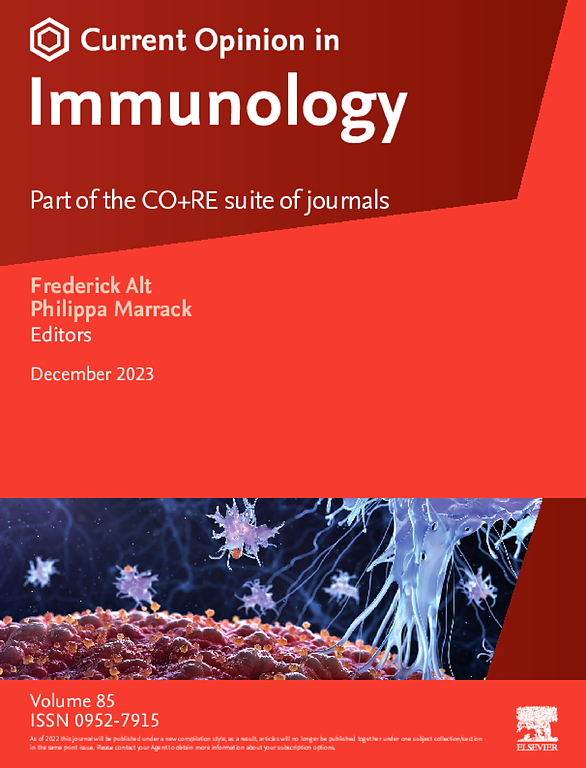T 细胞生命周期中的代谢足迹和逻辑。
IF 6.6
2区 医学
Q1 IMMUNOLOGY
引用次数: 0
摘要
生命的一个简单定义是一个能够自我复制(增殖)和自我维持(新陈代谢)的系统。在细胞层面,新陈代谢的进化是为了推动增殖,增殖需要能量和构建模块,以便在分裂前复制细胞生物量。T淋巴细胞(或T细胞)是适应性免疫反应所必需的,它保护我们免受能够过度复制的入侵和恶性病原体的侵袭。为了获得对这些病原体的竞争优势,活化的 T 细胞可以在短短 2-6 小时内复制其生物量并分裂成两个子细胞,这被认为是脊椎动物所有细胞类型中最快的细胞分裂。因此,细胞新陈代谢的主要任务是将可用资源用于驱动 T 细胞的过度增殖。除此之外,T 细胞的生命周期涉及一系列有序的命运决定事件,这些事件驱动细胞在不同的细胞状态之间转换。在不涉及细胞过度增殖的生命阶段,T 细胞的新陈代谢程序更加灵活,以维持细胞的存活和维持,有时还会进行微调,以支持特定的细胞活动。在这里,我们重点讨论与细胞增殖最相关的中心碳代谢。我们举例说明了中心碳代谢的变化可能会也可能不会改变 T 细胞的命运,并结合 T 细胞的命运转变进一步探讨了一些概念框架,如代谢灵活性、金发姑娘原则、溢出代谢和效应信号代谢物。本文章由计算机程序翻译,如有差异,请以英文原文为准。
Metabolic footprint and logic through the T cell life cycle
A simple definition of life is a system that can self-replicate (proliferation) and self-sustain (metabolism). At the cellular level, metabolism has evolved to drive proliferation, which requires energy and building blocks to duplicate cellular biomass before division. T lymphocytes (or T cells) are required for adaptive immune responses, protecting us against invading and malignant agents capable of hyper-replication. To gain a competitive advantage over these agents, activated T cells can duplicate their biomass and divide into two daughter cells in as short as 2–6 hours, considered the fastest cell division among all cell types in vertebrates. Thus, the primary task of cellular metabolism has evolved to commit available resources to drive T cell hyperproliferation. Beyond that, the T cell life cycle involves an ordered series of fate-determining events that drive cells to transition between discrete cell states. At the life stages not involved in hyperproliferation, T cells engage metabolic programs that are more flexible to sustain viability and maintenance and sometimes are fine-tuned to support specific cellular activities. Here, we focus on the central carbon metabolism, which is most relevant to cell proliferation. We provide examples of how the changes in the central carbon metabolism may or may not change the fate of T cells and further explore a few conceptual frameworks, such as metabolic flexibility, the Goldilocks Principle, overflow metabolism, and effector-signaling metabolites, in the context of T cell fate transitions.
求助全文
通过发布文献求助,成功后即可免费获取论文全文。
去求助
来源期刊
CiteScore
13.30
自引率
1.40%
发文量
94
审稿时长
67 days
期刊介绍:
Current Opinion in Immunology aims to stimulate scientifically grounded, interdisciplinary, multi-scale debate and exchange of ideas. It contains polished, concise and timely reviews and opinions, with particular emphasis on those articles published in the past two years. In addition to describing recent trends, the authors are encouraged to give their subjective opinion of the topics discussed.
In Current Opinion in Immunology we help the reader by providing in a systematic manner: 1. The views of experts on current advances in their field in a clear and readable form. 2. Evaluations of the most interesting papers, annotated by experts, from the great wealth of original publications.
Current Opinion in Immunology will serve as an invaluable source of information for researchers, lecturers, teachers, professionals, policy makers and students.
Current Opinion in Immunology builds on Elsevier''s reputation for excellence in scientific publishing and long-standing commitment to communicating reproducible biomedical research targeted at improving human health. It is a companion to the new Gold Open Access journal Current Research in Immunology and is part of the Current Opinion and Research(CO+RE) suite of journals. All CO+RE journals leverage the Current Opinion legacy-of editorial excellence, high-impact, and global reach-to ensure they are a widely read resource that is integral to scientists'' workflow.

 求助内容:
求助内容: 应助结果提醒方式:
应助结果提醒方式:


